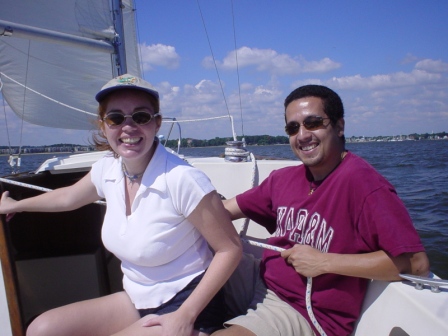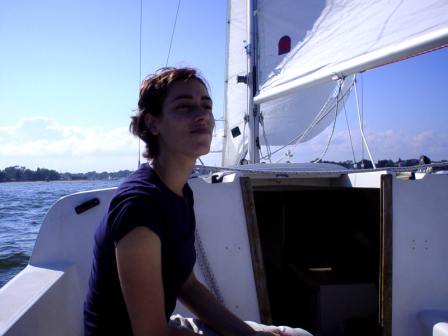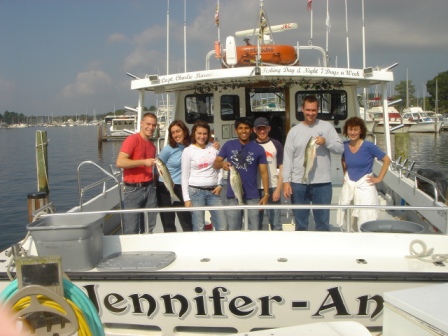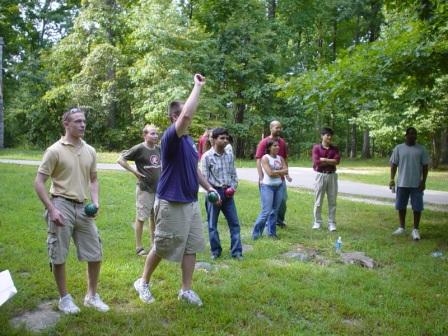|
|
Theresa Good
Professor
B.S. (1983) Bucknell University
M.S. (1985) Cornell University
Ph.D. (1996) University of Wisconsin-Madison
Address:
|
UMBC
Chemical & Biochemical Engineering
ECS 314
1000 Hilltop Circle
Baltimore, MD 21250 |
Phone:
|
(410) 455-3400 |
Fax:
|
(410) 455-1049 |
E-mail:
|
tgood@umbc.edu |
|
Research
in
Cellular Engineering
The
research we do in our lab is in the area of
cellular
engineering. We use a variety of engineering tools to analyze reactions
that
occur on the surface of cells and/or within cells to try to understand
the
mechanism of various diseases. We then use that information to try to
alter the
selectivity of those reactions such that we prevent or slow the
progression of
disease. For example, some proteins, such as beta amyloid of
Alzheimer's
disease, interact with neurons. If the protein is
in a normal or "healthy" conformation, the interaction is benign,
while if the protein is in its amyloid or "pathogenic" conformation,
the protein-cell interaction leads to cell death. We would like to
understand
the mechanism of the protein-cell interaction and be able to
prevent it.
The
following students have worked with me (either advised or co-advised)
towards
their graduate degrees:
-
PhD
students: Michael Edwards, Roberto Linares, Dawn Rymer, Dina Triyoso, Steven
Sheng-Shih Wang, In Hong Yang, and Jennifer Ruiz Pacheco, Sungmun
Lee, Wanida
Wattanakaroon, James Henry,
and Dhara Patel.
-
Master’s
students: Meredith Chapeaux, Rene’ Elms, Vasaliki Kazantzi, Camilo
Velez Vega, Suk Joon Yoo, Qi Min Liu and Vinita Mehrotra.
-
Currently,
my former students are working for Proctor and Gamble, Motorola,
Exxon-Mobile,
OSI Software, Alpha Vax Pharmaceuticals, Pfizer, Taiwan University,
Louisiana State University or are students and postdocs
in various laboratories at Texas
A&M University, Georgia Tech and Johns Hopkins University.
-
The
current research group members include Chris Cowan, Irina Ramos,
Ben Keshet, Tony Geisz, James Pallikal, Shannadora Hollis, Izath
Aguilar, Deborah Lipman and Debbie Lin.
I am
always looking for independent, resourceful and creative people to
join the lab to work on all aspects of challenging and
important problems associated with human disease. But there
should
also be time for enjoying all aspects of life in graduate school.



Sailing on the Chesapeake with
me: Drs. Jennifer Ruiz and Guillermo Coward Kelly, Irina Ramos, Dr. Dhara
Patel, and Professor Castellanos. There are many more
sailing pictures.

After
a day fishing on the Chesapeake. From right to left,
Tony Geisz,
Irina Ramos, Laura Ciedera, James Pallikal, Ben Keshet, and me. We all
caught rockfish, but only some of us chose to "show off" our catch.
The department takes an annual
ski trip. John Kim and his wife, Professor Frey, Chris Cowan, Professor
Castellanos, Irina Ramos, Silivya Petrovka, Michael Johnson, Professor Marten
and son (Max) and me.

Chris Cowan and Tony Geisz, in the
foreground of the picture, have won the department bocce tournament two
years in a row.
We
have several ongoing research projects....
Engineering
of Drug Delivery
to T Cells
T
cells are one of the cellular components of the immune system.
Inappropriate
stimulation of a T cell by a normal protein results in healthy tissue
destruction. This mechanism is thought to be responsible for a number
of
diseases, including some forms of arthritis and diabetes. We are
constructing mathematical models of T
cell response and using them to help in the design of antisense and
photodynamic therapies to treat T cell diseases.
Exploration of
the Role of
Biomechanical Forces in Neurodegeneration
A
number of diseases affecting central nervous system tissue, such as
glaucoma,
head injury, and hydrocephalus, are characterized by elevation of
intraocular
or intracranial pressure and/or local shear stress and strain. We
propose that
the neurodegeneration in these diseases is a direct result of the local
shear
stress and strain acting on neurons. My students are developing an in
vitro
model of shear stress and strain induced neurodegeneration which can be
used to
elucidate steps in the mechanism of shear stress and strain induced
neurodegeneration and to test new compounds for the treatment of
diseases such
as glaucoma and head injury.
Protein
Aggregation and
Amyloid Diseases
At
least 16 different human proteins can fold abnormally resulting in the
formation of an amyloid fibril and some accompanying pathology. Two of
the best
known examples of these diseases are Alzheimer's disease and
transmissible
spongiform encephalopathies (such as Mad Cow disease). We are
investigating the
mechanism by which amyloid-forming proteins cause neurodegeneration and
exploring the relationship between peptide structure and biolgoical
activity.
We are also developing biomimitic polymers as potential therapeutics
for use in the prevention of amyloid toxicity. Our
research could lead to the development of cures for these otherwise
fatal
diseases. In addition, we, along with
Dr. Gerard Cote’ from Texas A&M University, are trying
to exploit our knowledge of these disease causing proteins to develop
novel
sensors for various amyloid diseases.
Selected
Publications
Cells Under Stress
D. Triyoso and T. Good. Pulsatile Shear Stress leads to DNA
Fragmentation in Human SH-SY5Y Neuroblastoma Cell Line. J. Physiology , 515:
355-365, 1999.
M. Edwards, S-S Wang, and T. Good. Role of Viscoelastic Properties of
Differentiated SH-SY5Y Human Neuroblastoma Cells in Cyclic Shear Stress
Injury. Biotechnology Progress
17: 760-767, 2001.
M. Edwards and T. Good. Use of a Mathematical Model to Estimate Stress
and Strain During Elevated Pressure Induced Lamina Cribrosa
Deformation. Current Eye
Research. 23: 215-225, 2001.
S.-S. Wang and T. Good. Effect of Culture in a Rotating Wall Bioreactor
on the Physiology of Differentiated Neuron-like PC12 and SH-SY5Y Cells,
J. Cellular Biochemistry. 83:
574-584. 2001.
Amyloids
D. Rymer and T.
Good.
The Role of Prion Peptide Structure and Aggregation in
Toxicity and
Membrane Binding. J. Neurochem,
75: 2536-2545, 2000.
D. Rymer and T. Good. Amyloidogenic b(1-40), b
(25-35) and Bovine Calcitonin Are Toxic Via A Common Pathway Involving
G Protein Activation. J. Biol.
Chem., 276: 2523-2530, 2001.
S.-S. Wang, D. Rymer and
T. Good. Cholesterol and Sialic Acid Removal Protects Cells from the
Toxic Effects of b-Amyloid Peptides. J. Biol. Chem. 276:
42027-42034, 2001.
S.-S. Wang, A. Becerra-Arteaga, and T.Good. Development of a
novel diffusion-based method to estimate the size of the aggregated Ab species responsible for
neurotoxicity. Biotechnology
and Bioengineering, 80, 50-59, 2002.
S.-S. Wang, V.
Kazantzi and T. Good. Kinetic analysis of the mechanism of b-amyloid induced G protein
activation. J Theoretical
Biology. 221: 269-278, 2003.
S.-S. Wang, S. Tobler, T. Good, and E. Fernandez. Hydrogen
exchange-mass spectrometry analysis of b-amyloid peptide
structure. Biochemistry.
42: 9507-14, 2003.
S. Lee, K. Carson,
A. Ficht., and T. Good. Hsp20, a novel a-crystallin, prevents Ab fibril formation and
toxicity. Protein Science. 14:
593-601,2005.
S. Lee, K. Carson, A.
Ficht
and T. Good. Small heat shock proteins differentially affect Ab
aggregation and toxicity. BBRC
347: 527-533, 2006.
D. Patel, J. Henry and T. Good. Attenuation of beta-amyloid
induced toxicity by sialic acid-conjugated dendritic polymers. BBA General Subjects
1760: 1802-1809, 2006
D. Patel and T. Good. A
rapid method to measure b-amyloid induced toxicity in
vitro. J. Neuroscience Methods
161: 1-10, 2007.
S. Lee, E. Fernandez and T. Good.
Role of aggregation conditions in structure, stability and toxicity of
intermediates in the Ab
fibril formation pathway.
Protein Science. 16: 723-732, 2007.
D. Patel, J. Henry and T. Good. Attenuation of beta-amyloid
induced toxicity by sialic acid-conjugated dendrimers: role of sialic acid
attachment. Brain Research (accepted), 2007.
T cells
R. Linares, J.
Ruiz
Pacheco, and T. Good. Efficacy of Different Targeting Agents in the
Photolysis of Interleukin-2 Receptor Bearing Cells. J
Photochemistry and Photobiology, B. 77: 17-26, 2004.
Sensors
B. Jung, S. Lee, I.H. Yang, T. Good, and G. Cote’. Automated On
Line Noninvasive Optical Glucose Monitoring in Cell Culture System, Applied Spectroscopy. 56: 511-57,
2002.
J. Henry, A.
Anand, M.
Chowdhury, G. Cote’, R. Moreira, and T. Good. Development of a
nanoparticle based - surface modified fluorescence assay for the
detection of prion proteins. Analytical
Biochemistry. 334:1-8, 2004.
A. Simonian, T.
Good,
S.-S. Wang, and J. R. Wild. Nanoparticles-based Optical Biosensor for
Direct Detection of Organophosphate CW Agents and Pesticides.
Analytica Chimica Acta. 534:
69-77, 2005.
A.
Anand, R. Moreira,
J.
Henry, M. Chowdhury, G. Cote' and T. Good. A bio-sensing strategy for
the detection of prions. LWT - Food
Science and Technology. 38: 849-858, 2005.
H. Beier, C. Cowan, I.H. Chow, J.
Pallikal, J. Henry, M. Benford, J. Jackson, T. Good, and G. Cote’.
Application of Surface Enhanced Raman Spectroscopy for Detection of Beta Amyloid
Using Nanoshells. Plasmonics. 2: 55-64, 2007.
Biocomplexity
N. Kazantzis and T. Good. Invariant Manifolds and the Calculation
of the Long Term Asymptotic Response of Nonlinear Processes Using
Singular PDEs. Comput. Chem.
Eng. 26: 999-1012, 2002.
M. Rodriguez, T. Good, M.
Wales, J. Hua, and J. Wild. Modeling Allosteric Regulation of de novo
Pyrimidine Biosynthesis in Escherichia coli. J. Theoretical Biology
. 234: 299-310, 2005.
N. Kazantzis, N. Huynh, and T. Good.
A model based characterization of the long term asymptotic behavior of
non-linear discrete time processes using invariance functional equations.
Computers in Chemical Engineering. 29:2346-2354, 2005.
Sponsors
- NIH
- FDA
- NSF
- NASA
- American Health
Assistance
Foundation
- Welch Foundation
Recent Awards
- Donald Creighton
Memorial Faculty Award for Graduate Student Mentoring, 2007.
- AIChE Food,
Pharmaceutical and Bioengineering Division Chair, 2007.
- ACS Biochemical
Technology Program Chair, 2006.
- Nominee HHMI, 2004.
- TEES Faculty Fellow,
2001-2002.
- TEES Faculty Fellow,
2000-2001.
- Ruth Salta Junior
Investigator
Achievement Award for National Glaucoma Research, 1999.
- NSF Career Award,
1998-2002.
07/29/2007





